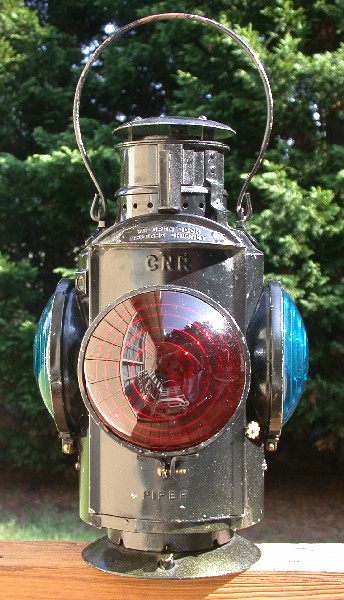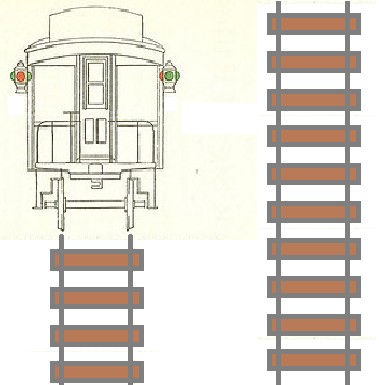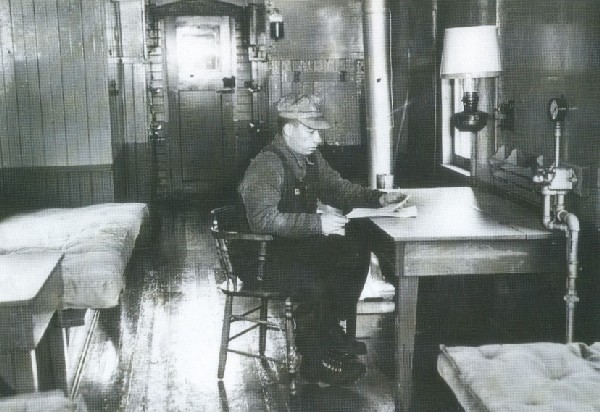

JeffPo's Canadian National Railways Marker Lamp Page
Last update: 10/26/15


This is a railroad marker lamp (i.e. caboose lamp) made by the Hiram L. Piper company. It belonged to the Canadian National Railway and is marked with CNR.

The
lamp has three signal green lenses and one red lens.
The lamp can be rotated to show either a red light to the
rear, or a green light to the rear (the red would be facing the railcar thus not
in use).
As the train traveled the tracks, it would keep the red lens/light facing
to the rear, so it functions as a rear of train marker.
When the train would leave the main lines and pull into a siding, they
would turn the lamp to show a green lens/light to the rear.
This would let any following trains know that this train was safely off
the main line.

This lamp also differs in that the top (i.e. the smoke dome or vent) must be lifted open before the sliding panel can be moved up to access the inside of the lamp.

The fuel fount has a mounting system that keeps the fount elevated above the bottom of the lamp. I wonder if this was to prevent rust from moisture being trapped underneath the fount.

The best part about a lamp is lighting it up and watching the lenses glow. The glowing round spot between the top of the green and red lenses is the peep sight window. It allowed a user to look in and see if the flame was burning during daylight hours.

There is also a case where the two marker lamps would actually display different colors from each other at the same time. If there are multiple tracks, and the train is going against the normal current of traffic flow, it would display a red (or amber for some railroads) signal to the rear on the outside of the tracks, and it would display a green signal to the rear on the inside next to the track that is the normal current. Consider the above image with two mainline tracks. Letís assume the track on the right side is the normal current flow of traffic for a train going away from us. The train is on the left track. But the normal traffic flow for the direction the train is traveling is actually on the track on the right. So the marker lamps show red on the left side, which is on the outside of the tracks, and green on the inside, next to the normal current of traffic flow track. If the train had been traveling on the track on the right, which would be the normal flow of traffic, then it would display the typical red signal on both sides of the railcar.
History of this lamp

This lamp seems to have been used very little if at
all. Itís in great shape.
Whether or not it spent much time on the actual railroad, it
came from the estate of Clarence Sykes, who did work with the railroad.
He worked as part of a caboose crew for a Canadian railroad for many
decades. Perhaps he manned a caboose like the
one shown above. Itís a wooden
caboose at the Fort

As shown in the image, this particular caboose has a marker lamp attached to it. There should be one on the other side of the caboose too.

Is this an image of an office setting?
In a sense, yes. This is the
inside of a caboose that was on the Toronto, Hamilton
&
I purchase the lamp from Mr. Sykes grandson, Jason Canuck.
I donít know if this lamp was mounted to Mr. Sykesí caboose car or
just one from the railroad. Clarence
Sykes was also a lighthouse keeper, and worked at the saw mill in Victoria
Harbour, Ontario, Canada.
Canadian National Railways

This image shows a Canadian National Railway steam locomotive being oiled in Sherbooke, Quebec. Feb. 23, 1957.
The Canadian National Railways (CNR) was created between 1918 and 1923, made up of several railways that had gone bankrupt and were in the federal governmentís hands. It was founded in December of 1918 in title only, with no corporate powers, from the Canadian Northern Railway, Canadian Government Railways, the Intercolonial Railway of Canada, the National Transcontinental Railway, and the Prince Edward Island Railway. The CNR grew as other railways went bankrupt and were added to it. It was born out of both wartime and domestic urgency. In 1923, the CNR Radio Department was created to provide passengers with radio reception for entertainment.
The CNR also built and operated their own resort hotels. While originally intended to give passengers a way to rest during long voyages, they were nice enough that people started using them as vacation getaways.
The CNR was privatized in the mid 1990s.
Today it is the largest railway in